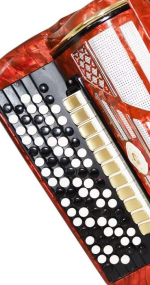Jaime_Dergut
Active member
Hello everybody,
Some days ago, when I was trying to play a harmonized march on my bayan, I realized that reaching some buttons while playing a tetra/penta chord is somehow uncomfortable.
So, that made me wonder, will this be easier if I have another 2 rows at the top?

What's really the purpose of having 5 rows of buttons instead of 3?
I am curious. In some russians videos I have seen about this, they say is more convenient in order for your fingers to reach out some of the buttons at the top (depending on the melody) but they don't explain much beyond that.
That will be everything.
Thanks for your time and attention.
Some days ago, when I was trying to play a harmonized march on my bayan, I realized that reaching some buttons while playing a tetra/penta chord is somehow uncomfortable.
So, that made me wonder, will this be easier if I have another 2 rows at the top?

What's really the purpose of having 5 rows of buttons instead of 3?
I am curious. In some russians videos I have seen about this, they say is more convenient in order for your fingers to reach out some of the buttons at the top (depending on the melody) but they don't explain much beyond that.
That will be everything.
Thanks for your time and attention.










